Screen
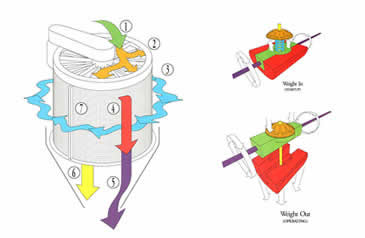
How It Works
These descriptions and diagrams are to help educate you on Symons unique screening process and design. Plus introduce you to terminology and product accessories that may be helpful in the process of customizing your solution.
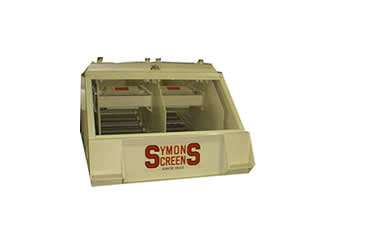
It's not what you shake...It's how you shake it!
Screening equipment is designed to work with gravity and a vibrating action of some kind. Symons K Screens combine the most efficient screening action with the most flexible, adjustable vibrator in the industry.
In all the K Screens, each of the screen decks are attached to a chassis with a strong unique rocker system at one end and powerful coil springs at the other. The screening surface at the feed end is inclined at approximately 20° while at the discharge end the incline is only about 5°. The Vibrator is specifically located to impart an in-line motion at the feed end, and then changes so that at the discharge end the deck oscillates in a backwards oval up and down motion. The in-line motion at the feed end quickly gets the material moving rapidly over the screening surface, while at the discharge end the material slows down so that all material has an opportunity to pass through the screening rods with very little, if any overage.
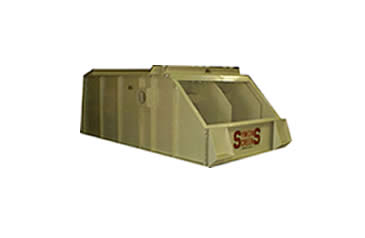
Highest screening capacity
The K Screens powerful vibrator, together with the unique suspension of the screen surface, gives them the highest screen capacity for their size in the industry. All this with virtually no dampening effect under the heaviest of loads. We have been making and improving the K Screens for nearly 50 years. All the K Screens work along the same design principle: rugged construction, the powerful K Vibrator, screen decks consisting of parallel tempered steel rods, and simple, hassle-free drive mechanisms. This means that the greatest tonnages can be put through these units and operated at the least cost. Because not everyone has the same kind of application, Symons offers four different K Screens to better suite your situation.
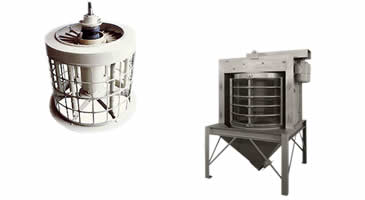
Rotating vibrating screen
The Symons V Screen multiplies screening action by combining centrifugal and gravitational forces, resulting in a larger capacity, highly efficient single cut, in either wet or dry separations.
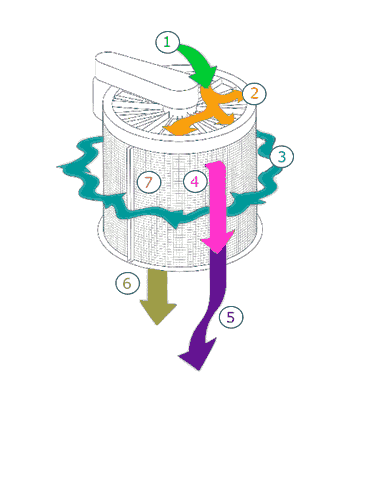
1 Material Is Introduced at Top
Delivered by the usual methods, the material is spread evenly onto a vaned distribution plate on top of the rotating, vibrating screening drum.
2 Centrifugal Force Evenly Distributes Material Along Top of Screen
The vaned sections of the distribution plate throw the material outward and towards the inside top of the drum, around which is fastened the screening cloth. Greater screening action results from this method by making full use of the screening surface. The feed is evenly distributed around the twelve-foot circumference, preventing buildup of material in one part of the screen while other areas are empty.
3 Rotating Vibrating Screen Drum Comes In Contact With Screen
The unique combination of physical forces creates a screening action five times the force of gravity. The drum rotating at a constant speed is geared to gyrate through a half-inch circular path 14 times for each revolution. In this way, the material is subject to over 1,000 pulsations per minute on the screening surface. It is here that the centrifugal force in the material causes it to strike the screen surface 50% more often than with a conventional vibrating screen.
4 Sized Material Passes Through and Down
The gyrations bounce the material around but again, the centrifugal forces push the material through the openings in the screen, while gravity pulls it downwards across it. The material is always striking the screening surface head-on, which in addition to increasing the capacity, helps to reduce blinding and reduces frictions so your cloth last longer. The small amplitude, high-frequency gyrations and rotating action in a vertical plane gives the Symons V Screen a greater capacity. It has a more efficient screening effect than flat or incline screens, which rely on gravity alone to pull the undersize through the openings.
5 V-Shaped Chute Collects Troughs
After sizing, the undersized material, having passed through the screen is discharged at the bottom of the V shaped collection chute.
6 Oversized Material Drops Down Through Middle
The oversized material is carried away in a downward spiral path around the base of the drum to the tapered collection chute.
7 Screen Is Easy To Attach And Remove
Doors on either side open to allow easy access to the screening drum. Two equally sized pieces of screen cloth are wrapped around the drum cage. They are held in place by tensioning them together along strips mounted on the short ends of the screen. Then the strips are bolted together and you are ready to roll.
The basic reason for a vibrating screen is to accomplish a separation of a granular product into various sizes. In order to effect this separation the various size particles must be given as many opportunities as possible to pass thru the screening medium. Particles that adhere to one another must be dislodged and stratification or sifting of the fines down to and thru the screening media must be accelerated. The best means of accomplishing this is by moving (vibrating) the screen under the product as often as possible to allow the product multiple chances of being sized.
Common Vibrating Screen Applications
Scalping Screen
Used to remove a small amount of oversize from a feed which is predominately finer without regard for finished product sizes.
Sizing Screen (Dry or Wet)
Used to produce material sizes that meet specifications in a particular range of sizes. Usually expected to perform at a high and constant rate of efficiency.
Washing Screen
Equipped so that water can be sprayed on the material. Normally water is used to clean material and or assist in the sizing.
Dewatering Screen
Used to remove liquid from material.
Rescreen Screen (Dry or Wet)
Used to remove fines or contaminants from previously screened material. Often called dedusting screen (dry) and desliming screen (wet) or a polishing screen.
Two Bearing Circle Throw (Unbalanced) Inclined Screens
One of the earliest and simplest machines developed was the Two Bearing Circle Throw. These machines depend on gravity to effect a rate of travel of material over the screen surface, therefore they are sloped between 15° to 30° from the horizontal for dry separations and somewhat flatter for wet sizing. The screening surface is general drawn tightly over an open framework and anchored to vertical side plates with tension members to keep it sealed tight. Fastened to the side plates, normally through the center and near the center of gravity, is a shaft supported at the side plates by two bearings. A pulley or sheave is attached to one end of the shaft and a driving mechanism usually an electric motor thru a V-belt is attached.
The screen frame is supported by springs as each corner allowing it to move freely in a vertical circle. Therefore, it is often referred to as "Free Floating". The screen frame is vibrated by attaching equal weights eccentric to each end of the shaft often called counterweights. As the shaft with counterweights attached is rotated it throws the frame in opposite direction of the counterweights. Since the direction is constantly changing thru an arc of 360° the effect on the live frame is a circular throw or stroke. The magnitude of the stroke can be varied by increasing or decreasing the amount of counterweight.
Counterweight is often built into the shaft eccentric to the centerline of the bearings or attached with plates to the shaft or a combination of outboard and or externally attached central counterweights are used.
The Two Bearing Screen is a versatile type of screen. Variations in stroke, speed, slope, and direction of rotation all can be used to give the best combination for sizing a product.
Four Bearing Positive Stroke Inclined Throw Screens
The Four Bearing Screen frame is similar to the Two Bearing Screen however, the shaft is eccentrically machined on the ends and supported by two additional outboard bearings located on a stationary base frame or on a resilient mount attached to a base frame. The driven sheave is installed on one end of the shaft next to the outboard bearings. Since the two bearings on the screen and the two on the stationary housing are in different planes, rotation of the shaft causes the screen to move in a circle about the center of the outboard bearings. You could equate this to a crank action.
In order to counteract vibration, a counterweight or counter balance is installed between the bearings on the centerline of the outboard shaft or these weights may be part of the shaft placed between the inboard bearings. This counterweight does not act as the one on a Two Bearing Screen, but is used to counteract the weight and centrifugal force of the live frame on the shaft at the inboard bearings and reduce or eliminate vibration. This counterweight is 180° to the direction of the stroke of the screen at all times.
The positive stroke screen, often referred to as a four-bearing screen, starts and stops very smoothly. The performance of a Positive Stroke Screen can be varied by changing the speed, direction of rotation and inclination. The stroke can be changed by modifying the eccentric of the shaft since this is the source of the stroke.
Horizontal screens came into existence in order to save headroom and because there was a need to better control fluids and dewater coal and other products, they since have become very popular for these applications as well for many sizing operations.
The primary difference in the horizontal screen is its ability to convey the product since gravity is no longer a force in moving the material over the screen surface. Another feature of most Horizontal
Screens is that they incorporate two shafts and produce an essentially straight line stroke at an angle to the horizontal in the direction of material flow. This throws the oversized material out of the apertures and conveys it along the screen. The action is necessary since horizontal screens don't have the benefit of being installed with a down-hill inclination.
Types of Horizontal Screens
Due to their conveying feature horizontal screens can operate slightly uphill, as much as 5°. Beneficial in some dewatering applications.
Gear Driven Horizontal Screens
Use gears to control the relationship of the shafts. Changes to the nominal 45° line of action can be made by retiming the gears to give either a flatter angle for faster rate of travel or a steeper angle for longer retention of material on the surface and possible sharper sizing of the product.
Chain Driven Horizontal Screens
Instead of gearing together the eccentric shafts, a chain and sprocket arrangement can be used to accomplish the same end as the use of gears.
Multiple Eccentric Shaft Horizontal Screens
Larger units requiring more driving force. Accomplished by gearing together more than two shafts or adding more vibrators.
Synchronized Shaft Horizontal Screens
Shafts are geared together or linked by a chain drive. Instead each shaft is driven independently by a separate motor.
Two Shaft Horizontal Screen
The vibrator consists of two shafts with eccentric counterweights attached and supported at each end by roller bearings. The shafts are driven so that they operate in opposite directions. The counterweights forces are additive when in line and cancel out when opposed. The vibrator is normally located so that the line of action is at approximately 45° to the center of the mass of the screen frame. Since the reactions from the counterweights cancel out one another at all points except two during a cycle the result is a nominal straight line or elliptical motion.
Single Eccentric Shaft Horizontal Screen
The principle of producing the vibration in this type of screen is similar to the Inclined Four Bearing except the screen deck is held in a horizontal position by the use of both coil and leaf springs. The thrust motion produced by the crank shaft pulls the deck forward and upward. It is guided in its movement by the leaf springs. The coil springs also add upward and forward thrust to the deck.
Balanced Two Mass Single Shaft Horizontal Screens
This unit is composed of two masses, one consisting of a screen frame mounted on leaf springs and attached to the crank or eccentric portion of the drive and another counterweight frame attached to the concentric portion of the shaft. The screen frame movement is limited in direction by the angle of the leaf springs. The stroke is a major arc about the fixed spring mount.
Screens for specific purposes require certain accessories to perform that purpose. Other accessories are to reduce maintenance. Some modifications and variations of screens are used to accomplish particular operations.
Ball Tray Decks
Deck located under another deck which retains rubber balls. The bouncing balls impart a secondary vibration to the screening deck above to reduce plugging and binding.
Blank Plates Section
A deck with no openings used to convey product after it is sized on an upper deck.
Dams
Used to retard the product on a deck for a longer period, generally in order to dewater it better.
Electrically Heated Decks
Resistance heat applied to the wire cloth to reduce the tendency of material to stick to the wires.
Longitudinal Divers or Partitions
Used to process two or more different products on the same screen surface.
Lump Breakers
External weight suspended over a screen surface to break lumps such as sand or agglomerated material. Many varieties of lump breakers are used.
Spray Pipes
Equipped with spray nozzles for water located along the deck to wash the product and aid in screening.
Spray Pipe Holes
Placed in the screen side plates to accommodate spray pipes. Holes are general 5" in diameter or larger, however, if spray pipes are affixed the holes need only be large enough to insert the pipe.
Step Decks
A succession of steps in the deck to turn or flip the product for better removal of fines.
Troughs
A recessed section in a deck to aid in mixing or pulping a product. Usually used with sprays.
Backplates
Installed at the feed end of the screen. They eliminate spillage from the decks.
Discharge Lips
Extensions to the deck to discharge material in the proper chute or bin and allow for the chute to clear live frame.
Feed Boxes
Installed ahead of a screen surface to take impact and spread the feed.
Hand Holes
Sometimes provided to allow the operator to change screen cloth from outside the live frame.
Liners
Installed wherever product can wear the live frame. These may be made from steel, rubber, plastics, ceramics or other materials. They protect vital parts which, if weakened, could lead to failure.
Lifting Eyes or Lugs
It is important to properly handle a screen prior to installation. Manufacturers often install lifting eyes or lugs in the proper locations to avoid damage in unloading and installation.
Tension Wedge Fasteners
Devices that replace tension bolts. They allow for rapid screen retensioning and speed cloth changes.
Carts or Carriages
Special carts are sometimes used to wheel away discharge chutes to gain access to the screen for cloth changes and maintenance. Some screens are installed on wheel mounted carriages to allow for rapid change-over of screens in critical service.
Drive Guards and Shields
Many types of shielding devices are necessary to protect personnel from accidental injury. The V-belts and sometimes the motors must be guarded. Large lumps must be contained on the screen surface. Clearance points between vibrating screens and stationary external structures should be avoided and guarded.
Enclosures
Often used to contain dust and noise. They are of two basic varieties. 1-Vibrated Enclosures attached to the screen frame which vibrate with it and 2-Stationary Enclosures that surround the live frame but do not move with it.
Friction Checks
A motion dampener of the friction brake type which minimizes stroke build-up during start and stop and may also stabilize a screen during operation.
Motors
The driving force required to operate screens. The majority of these are electric with a few gasoline or diesel engines. There are also hydraulic drive motors. Most of the electric motors are hi-torque to overcome the inertia of the large eccentric counterweights. Totally enclosed fan cooled is also a very common motor requirement due to the dusty atmosphere in screen operation.
Pivoted or Spring Loaded Motor Bases
Take up the initial torque of a motor to reduce strain on the motor and keep tension on the belts.
Rubber
Many forms of solid rubber are used to absorb shock and store energy.
Snubbers
A flexible device that restricts motion.
Springs
Many types are used to isolate vibration transmittal from vibrating screens and to direct the line of motion, absorb shock loads, transmit and limit stroke, maintain tension such as:
1 - Coil Springs
The most common type of spring used to support the load and absorb shock.
2 - Leaf Springs
Used most extensively to direct the line of action.
3 - Air Springs
Used in place of coil springs. These inflatable rubber springs are used to reduce vibrations and noise. They can be made hard or soft by regulating the air pressure.
4 - Solid Rubber Springs
Perform the same function as coil or air springs.

